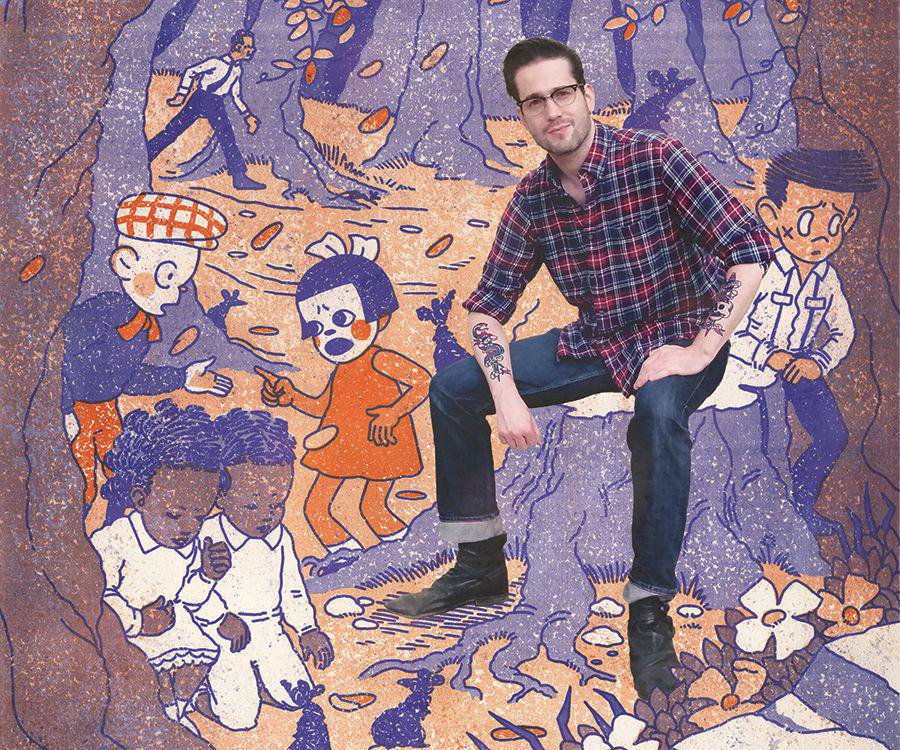Profiles
Seven Questions With Cole Closser
The local artist recently published his second full-length book and is gaining national attention for his vintage drawing style and interesting short stories.
By Rose Marthis
Dec 2015

Cole Closser is a self-described small-town boy from Springfield who knew he wanted to be an illustrator at a young age. He tried to leave drawing for painting, but comics pulled him back in. Now he works as an art and design professor at Missouri State University and has two published full-length books and numerous smaller works under his belt. His first book, Little Tommy Lost, follows the adventures of a lost little boy as he searches for his parents in a big city, and was featured in The Best American Comics 2015. His newest book, Black Rat, is a collection of shorter stories with one common character—Black Rat—traveling through different time periods and worlds. The book, illustrated and written by Closser, came out in September and has since gotten national attention at conventions and was recently reviewed by The New Yorker. Closser sat down with us to talk about the work that goes into producing a full book start to finish, and his advice for young artists.
417 Magazine: Where did you first find your love of drawing?
Cole Closser: I thought I wanted to be a children’s book illustrator. But when I was about 11, I was digging through the basement of my dad’s house. While digging through boxes I came across this comic called RAW, put together by Françoise Mouly and Art Spiegelman. I read it, and I knew I wanted to do that. When I was about 22, I was trying to be a serious portrait painter and landscape painter, but I was told over and over again that that isn’t real art—only abstract stuff is art. It kinda turned me off to painting altogether, and I tried to find what it was I loved about drawing in the first place and where that love came from. I realized comics were still at the heart of it, so I really committed myself to studying the craft and the history.
417: What inspired to write your first book?
C.C.: Sometime later I had a few experiments under my belt, and I started [my first book] Little Tommy Lost because I wanted to see if I could do something every day. I did one strip every day. It’s made to look like an old daily newspaper adventure strip. I didn’t know that these people had assistants back in the day, so I wore myself out doing the penciling, the inking, the coloring, and then the production work. But I just can’t stop at this point.
417: What part of Black Rat took the most time?
C.C.: I wanted the lettering on this last story to look like it was translated from another language. I used something called a Leroy Lettering Set. It has a stylus and a needle and you trace the grooves of the letters. It’s a 34-page story, and it took over 40 hours just to letter it. All of my lettering was done by hand, and it was so important to me that there were no computer fonts. It was painful, but I’m so happy that it worked out.
417: What’s the process of producing a book from start to finish?
C.C.: Black Rat took about three years off and on. The process was a little different for several of the stories. Essentially, I either get a story in mind or I get an image in mind that I want to play with and then I take notes. My sketchbook is mostly handwritten notes, and I’ll try to sketch out little scenes when I’m putting it together. Sometimes I come up with the words first and then I add the pictures; other times it’s the images first and then I add the words. Other times, it’s actually being made up as I go. Sometimes there’s a ton of revision and sometimes there’s very little. It’s just such a different process every time.
417: Describe your drawing style.
C.C.: I don’t even know if I have a style. What I tell my students when they talk about style is not to worry about it at all. A lot of young artists worry about style a lot—they want to have a particular look, and they feel like if their work can’t be categorized in a certain style then people won’t look at it. But styles are things that come to you, and then they leave you and then come to you again. You’ll have different styles over the course of your life. I think that a person’s inherent style is where they fail consistently. It’s a big distance between your brain and your hand and the paper. What you want to draw gets filtered through your mind, through your neck, through your shoulder, through your arm, through your hand, through whatever tool you’re trying to get good at drawing with. Between those, you lose what you were trying to make, and it’s in those failings where they show up consistently that I think a style exists.
417: What other advice do you give to students and young artists?
C.C.: Be nice to people. Work hard. I really do have a ‘be nice to people’ speech that I give to my classes. The biggest part of anything is being kind and being sincere. There’s no irony in any of the work that I do. It’s 100 percent from-the-heart, just as sincere as I can make it because I don’t want to induce eye-rolls. I’m okay with groans, but I always want it to be real.
417: What’s next for you?
C.C.: I’m here for the foreseeable future. I hope that I just stay here and continue to teach college art and design classes and continue to publish. I hope that by the time that I’m old and have trouble moving around that I have a string of books behind me that have made a number of people happy. That’s all I want.
417: Do you draw all your pages by hand?
C. C.: I use dip pens, brush and graphite. I do all the drawing, and then I scan it. For the most part, the color is done digitally using Photoshop. I did play around with some real-world media, but for the most part, it’s drawn with physical media, scanned and then colored digitally. I have been known to use other tools and media from time to time in my comics. Black Rat has watercolor, colored pencil and even two short sections that were drawn 100-percent digitally in Manga Studio EX. But then I go to great lengths to imitate old production techniques. I try to make things look like they’ve come off of a printing press. I really like that feeling. I want them to feel like old printings that are then scanned and put into a book.
417: Where do you find inspiration?
C. C.: I draw inspiration from a lot of childhood memories, or things that have happened in my life. Visually, the inspiration comes mostly from whatever I’m currently reading or currently into. I try to never directly reference anybody who’s currently producing work. It’s always people that are gone, so that it’s obvious that it’s an homage and not just taking something.
417: How did you get into teaching?
C. C.: I always wanted to be a teacher, specifically a college art teacher. Both of my parents were college professors. They both taught English literature, so I grew up kind of in that environment. From a little boy, those were my goals: to be an author and a teacher. It just kind of all fell into place, and I got lucky that I was able to do it here in Springfield.
417: Did your parents give you your drawing ability too?
C. C.: They could both draw really well. I think everybody has a level of inherent drawing ability. Everyone is so committed to it when they’re little kids, and then at some point you start comparing yourself to other people instead of just enjoying it. Some people keep doing it no matter what, and other people pull back. My parents were the type that pulled back, but they shouldn’t have. I think everyone should embrace drawing if you enjoy doing it, because it’s a skill like anything else. You get better just by doing it.
Cole Closser’s Top 5 Comics
The local comic book author shares the graphic novels that influenced his craft.
RAW Vol. 2, #1–3
by various artists
RAW is everything to me. Through their curation of artists and stories, Françoise Mouly and Art Spiegelman helped to define what comics are really capable of. For me, RAW is the bar for intellectual, experimental, literary or art comics and it’s set incredibly high. No amount of praise or hyperbole can really cover the importance of the work collected in RAW. While there have been many excellent anthologies for groundbreaking work in the medium, RAW has (in my own less-than-humble opinion) never been surpassed.
Maus I & II
by Art Spiegelman
I first read Maus through excerpts in RAW. It is heartbreaking, brutal, sincere and nearly impossible to put down once you start reading. In telling the story of his parents surviving the Holocaust, Art Spiegelman deals with his family’s personal tragedies and traumas, and his own, while fighting himself (within the narrative in fourth-wall-breaking moments) about how to tackle those subjects with honesty and integrity. The writing reads as from-the-heart and unaffected, while the drawings are visceral, rough and raw. Maus also won a Pulitzer, so all arguments against it can be safely disregarded.
Danny Dutch and Lemon Styles
by David King
I’m cheating here and picking two books by this author, but I see them as parts of the same whole since they involve the same characters, themes and format. David King is arguably the most underrated or overlooked cartoonist in America. His work is equal parts stunning, subtle, beautiful, and bleak. Consisting of old-timey cartoon characters spread across four panels per page, with each page set up to function with the familiarity of a newspaper gag strip. The short stories, anecdotes, stream of consciousness ramblings and jokes mingle with unmatched craftsmanship in linework and lettering to create something wholly unlike any other comics out there while being utterly evocative of earlier times and secret, unremembered childhood experiences or ideas. I can’t say enough about how much I love Danny Dutch and Lemon Styles. I have read and reread (and reread) them.
Pop Gun War
by Farel Dalrymple
I read Pop Gun War (as individual, serialized monthly issues when it came out, before you could get the whole thing collected in one volume) during a very difficult time in my life. The strange mix of soft, lively, lovely drawing and dream-like dialogue gave me something to look forward to every month—and a genuine form of escape and immersion. Each of Farel Dalrymple’s characters is like some part of any reader’s personality, cut-and-pasted on the page. Even the monstrous villains are somehow compellingly sad, lonely or misunderstood. There’s a boy with wings. There’s a girl with a guitar. There’s a giant fish and the tiny man who loves him. Pop Gun War, along with RAW, may have had the biggest influence of any books on my wanting to tell stories through the medium of comics.
Walt & Skeezix
by Frank King
Drawn & Quarterly is currently collecting and releasing the entirety of Frank King’s historic Gasoline Alley in beautifully designed, hardbound volumes, titled Walt & Skeezix. This is not the Gasoline Alley of today, or even of the last 60 years, so readers should throw out any preconceived notions they have about the characters or the storylines that Frank King created nearly a century ago. Of course, like much fictional work created before the Civil Rights Movement, there are many unfortunate examples of racial insensitivity in the way that black Americans are caricatured, so sensitive readers should be forewarned to view these strips in the light of the time period they were created (this topic is also addressed in the introductory material). Each daily strip represents one day in the life of the characters, and those characters do age (an innovation in comics at that time), so it’s easy for a reader to get swept up as days turn into weeks, then months, then years—and the characters grow older, learn, and change. It’s a soap opera filled with heart that spans decades. I’ve laughed and cried and been utterly carried away while reading Frank King’s original run on Gasoline Alley.











